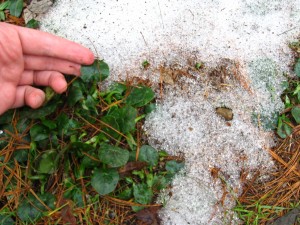buy gabapentin 300 mg uk  The snow is clearing away quickly in the city with this blast of warm weather, disclosing the life already growing beneath. The most striking are the marsh marigolds, Caltha Palustris, which have already formed leaves despite having a good foot of snow on top of them just last week. The fact that nature keeps to its schedule despite the cold and snow is impressive every year. I have never seen these plants in the Catskills, but they are common in New York City on moist wild ground – in certain places in Central Park they form emerald-green carpets in brown March and April. They bloom fairly spectacularly in April and May.
The snow is clearing away quickly in the city with this blast of warm weather, disclosing the life already growing beneath. The most striking are the marsh marigolds, Caltha Palustris, which have already formed leaves despite having a good foot of snow on top of them just last week. The fact that nature keeps to its schedule despite the cold and snow is impressive every year. I have never seen these plants in the Catskills, but they are common in New York City on moist wild ground – in certain places in Central Park they form emerald-green carpets in brown March and April. They bloom fairly spectacularly in April and May.
Higashimurayama-shi The leaves look fairly savory – they are thick and rubbery like spinach – but they are in the poisonous Buttercup family. Supposedly they were used by Native Americans for medicines on the principle that a little bit of poison won’t kill you but may just make you stronger, i.e. will kill smaller things that are trying to live inside you.
I attempted a year and half ago to stud the lawn in front of my cabin with daffodils. The daffodils bloomed last spring, but I found that the water table was only a few inches beneath the surface at that time due to snowmelt, the “wet feet” condition that typically kills bulbs. If I find I can’t grow daffodils there, the plan is to replace them with marsh marigolds, which don’t mind wet feet at all and are native to boot.
I have read websites claiming marsh marigolds are evergreen; they may be in other parts of their range, but in New York City the leaves completely senesce by late June and the plants have no above-ground presence until the following February.
Post a Comment